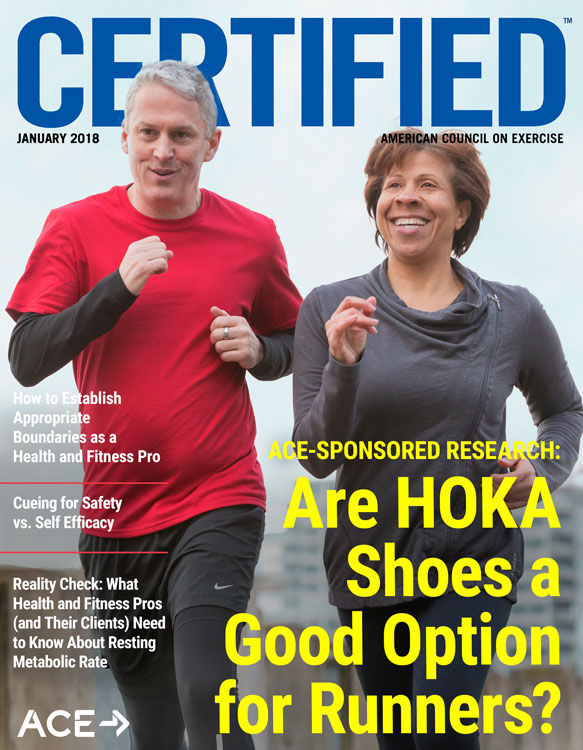
Introducing the Prescription for Activity Task Force

The American Council on Exercise’s mission is to Get People Moving. ACE, along with like-minded organizations across the country, has worked for decades to stem the rising tide of physical inactivity and obesity. What would happen if these organizations, from the national to community level, began to work in concert to pursue the singular goal of a more active, fit and healthy America?
In fall 2015, ACE began to conceptualize the best ways to help more people in the U.S. achieve the many benefits of a physically active lifestyle, most critically the prevention and treatment of disease. ACE believed that, in addition to an expansion and coordination of the many efforts already underway, a fundamental, systemic evolution of healthcare at its core was likely required. ACE theorized that if it convened a structured, think tank–style planning process involving a wide array of national thought leader–level stakeholders, that group could map out its evolution.
ACE asked a range of experts from academic, healthcare and community settings, in private, public and nonprofit sectors, to join the Prescription for Activity (PfA) Task Force and work toward a shared goal of formulating a detailed 20- to 30-year outcomes-focused “map” for transforming the healthcare system so that physical activity–based behavior-change interventions become more integral, and thus far more people achieve recommended physical-activity levels.
The PfA Task Force gathered in 2016 and early 2017 to examine the following questions:
- How can the healthcare industry mobilize people from communities across the U.S. to achieve recommended levels of physical activity—with a focus on those populations at greatest need?
- What steps might healthcare take to pursue the priorities and execute the strategies recommended by leading authorities such as the Physical Activity Guidelines for Americans, the American College of Sports Medicine’s Exercise Is Medicine, the National Physical Activity Plan Healthcare Sector and the U.S. Preventive Services Task Force?
- What steps would be required for clinical care and that which surrounds and supports it to become a force for a cultural shift leading to a healthier, more active U.S.?
The Prescription for Activity Task Force
Dominique Adair, MS, RD, Private-practice nutrition and fitness advisor, public speaker, educator, media consultant, and freelance health and nutrition writer
Katie Clarke Adamson, Senior Director of Health Partnerships and Policy, YMCA of the USA
Jason Altmire, MHA, Senior Vice President of Public Policy and Community Engagement, Florida Blue
Ross Arena, PhD, PT, FAHA, FESC, Professor and Head of the Department of Physical Therapy, University of Illinois at Chicago
Jordan Asher, MD, MS, Chief Clinical Officer/Chief Innovation Officer, MissionPoint Health Partners
Donald A. Balasa, JD, MBA, CEO and Legal Counsel, American Association of Medical
Assistants
Hope Barkoukis, PhD, RD, LD, Associate Professor/Interim Department Chair, Department of Nutrition, Case Western Reserve University
Grady Colson Barnhill, MEd, Senior Assessment Advisor, National Commission on Certification of Physician Assistants
Regina Benjamin, MD, MBA, 18th Surgeon General of the United States (2009–2013)
Gary Bennett, PhD, Bishop-MacDermott Family Professor of Psychology & Neuroscience, Global Health, and Medicine at Duke University and Director of Duke’s Global Digital Health Science Center
Jenny Bogard, MPH, Director, Healthcare Strategies, Alliance for a Healthier Generation
Victoria Brown, MPA, Senior Program Officer, Robert Wood Johnson Foundation
Cedric X. Bryant, PhD, FACSM, Chief Science Officer, American Council on Exercise
Stephen Cook, MD, MPH, FAAP, Associate Professor of Pediatrics, AAP-IHCW & University of Rochester Medical Center
Lance C. Dalleck, PhD, Associate Professor of Exercise and Sport Science, Western State Colorado University
Mary Daly, National Media Director, Anytime Fitness
Kitty Hsu Dana, MBA, former Vice President – Health, United Way Worldwide
Laura DeFina, MD, President and CEO, Cooper Institute
Greg Degnan, MD, Board Certified Orthopedic Surgeon and Medical Director, Atlantic Coast Athletic Clubs
William Dietz, MD, PhD, Director, Global Center for Prevention Wellness, George Washington University
Nicholas A. DiNubile, MD, Clinical Assistant Professor, Department of Orthopaedic Surgery at the Hospital of the University of Pennsylvania (ACE Chief Medical Advisor and former member, Board of Directors)
Erik Eaker, MHA, Director, Population Health Initiatives, Humana
John Ellis, Cofounder and CEO, Attune Health Management, and Vice Chair, Board of Directors, American Council on Exercise
Avery Faigenbaum, EdD, FACSM, Professor, Department of Health and Exercise Science, The College of New Jersey
Jennifer Fassbender, MS, former Associate Director of Exercise Physiology, American Diabetes Association
Jinger S. Gottschall, PhD, Associate Professor of Biomechanics and Kinesiology, The Pennsylvania State University
LaMar Hasbrouck, MD, MPH, Executive Director, National Association of County and City Health Officials
Rain Henderson, MPA, CEO, Clinton Health Matters Initiative, Clinton Foundation
Trina Histon, PhD, Senior Principal Consultant, Clinical & Operational Improvement, Kaiser Permanente, Health Management Institute
Anita Holloway, MD, MBA, Market Vice President/Medical Officer, Wisconsin and Tennessee Market of Humana
Janet (Frenkel) Jones, Chief Experience Officer, MissionPoint Health Partners and Ascension Care Management
Elizabeth (Liz) Joy, MD, MPH, FACSM, Medical Director, Community Health and Food & Nutrition, Intermountain Healthcare
James Kallusky, EdD, Vice President, Laureus Foundation
Lynn Cialdella-Kam, PhD, MA, MBA, RDN, LD, Assistant Professor, School of Medicine, Case Western Reserve University
Larry Kenney, PhD, FACSM, Professor of Physiology and Kinesiology, Noll Physiological Research Center, The Pennsylvania State University
Shane Kinkennon, Chief Strategy Officer, American Council on Exercise
David M. Krol, MD, MPH, FAAP, Senior Program Officer, Robert Wood Johnson Foundation
Ted Kyle, RPh, MBA, Founder and Principal, ConscienHealth
Felipe Lobelo, MD, PhD, Associate Professor, Hubert Department of Global Health, Rollins School of Public Health and Exercise is Medicine Global Research and Collaboration Center, Emory University
Matt Longjohn, MD, MPH, National Health Officer, YMCA of the USA
Lisel Loy, JD, Project Director, Bipartisan Policy Center
Beth Taylor Mack, PhD, Director, Health Behavior and Wellness Membership and Programs, YMCA of the USA
Patricia (Patty) Mecheal, PhD, MHS, Executive Vice President, Personal Connected Health Alliance
Craig W. Moscetti, MPH, Manager of Community Pediatric Health Programs, Allina Health and HealthPartners
Natalie Digate Muth, MD, MPH, RDN, FAAP, Senior Advisor for Healthcare Solutions, American Council on Exercise, and primary care pediatrician
Carmen Rita Nevarez, MD, MPH, Vice President of External Relations/Preventive Medical Advisor, Public Health Institute
Julianna L. Olson, NP, Market Medical Officer, Humana
Diane Padden, PhD, Vice President of Professional Practice and Partnerships, American Association of Nurse Practitioners
Sherry Pagoto, PhD, Associate Professor, Division of Preventive and Behavioral Medicine at University of Massachusetts Medical School
Pamela M. Peeke, MD, MPH, FACP, FACSM, Assistant Professor of Medicine, University of Maryland, Pew Foundation Scholar in Metabolism, National Senior Olympics Board
Edward Phillips, MD, Assistant Professor of Physical Medicine and Rehabilitation, Harvard Medical School
Nico Pronk, PhD, FACSM, FAWHP, Vice President and Chief Science Officer, HealthPartners
Chuck Runyon, CEO, Anytime Fitness
Robert Sallis, MD, FACSM, Co-Director, Sports Medicine Fellowship, Kaiser Permanente
Eduardo Sanchez, MD, MPH, FAAFP, Chief Medical Officer for Prevention, American Heart Association
Robin Schepper, MS, Senior Advisor, Nutrition and Physical Activity Initiative, Bipartisan Policy Center
James S. Skinner, PhD, FACSM, Professor Emeritus, Department of Kinesiology, Indiana University
Brian Smedley, PhD, Co-founder and Executive Director of the National Collaborative for Health Equity
Alison Steiber, PhD, Chief Science Officer, Academy of Nutrition and Dietetics
Sarah Strunk, MHA, Strategic Advisor, Active Living by Design
Paul Terry, PhD, President and CEO, Health Enhancement Research Organization
Calondra Tibbs, MPH, Senior Advisor of Public Health Programs, National Association of County and City Health Officials
Laurie P. Whitsel, PhD, Director of Policy Research, American Heart Association
Risa Wilkerson, MA, Executive Director, Active Living By Design
Antonio S. Williams, PhD, Assistant Professor, Indiana University School of Public Health
Jennifer L. Wiltz, MD, MPH, Senior Medical Officer, US Public Health Service & CDC Center for Chronic Disease Prevention and Health Promotion
Shale Wong, MD, MSPH, Professor of Pediatrics, University of Colorado
Deborah Rohm Young, PhD, FACSM, Director of Behavioral Research, Department of Research and Evaluation, Kaiser Permanente Southern California
The Theory of Change Approach to Strategic Planning
In order to answer these complex and far-reaching questions, the PfA Task Force utilized the theory of change (TOC) approach to strategic planning, which is often used to address highly complex social or system-level problems. It explains how a long-range goal can be reached through the attainment of a sequence of early and intermediate accomplishments.
Consider a client who asks his health coach to help him lose 30 pounds before his wedding next summer. The coach and client would then map out a plan to hit the goal of losing 30 pounds by a specific date. When it comes to exercise, perhaps the first idea is to attend four group fitness classes at the gym each week. The client then points out an obstacle: he works full time and volunteers after work one night each week, making that many trips to the gym unlikely. The next step would be to identify four time slots when the client could commit to making it to the gym, or find other ways to get his workouts in. The process continues this way, addressing both the nutrition and physical-activity components of the client’s plan.
In other words, the client and coach would be using the end-goal as a starting point and then work backward to figure out the stepping-stones goals and behavioral changes that would enable the client to reach his ultimate objective.
To create its systems-change map, the PfA Task Force:
- Identified the long-term goal, or “Ultimate Outcome”
- Developed a pathway of change, including measurable outcomes that would be necessary “incremental outcomes,” or stepping-stones toward achieving the Ultimate Outcome
- Arranged those incremental outcomes into sequences of cause-and-effect preconditions, the result of which have evolved to represent “chains” of necessary categories of work
- Described the stakeholders that might logically be involved, or are already involved, in the pursuit of each precondition within each chain
- Identified approaches, interventions and other strategies that might be deployed in pursuit of each precondition
The TOC process begins with determining the Ultimate Outcome:
Culture Transformation:
Across diverse population groups within the U.S., being physically active is prioritized, feasible and enjoyable.
As Measured By:
50 percent or more of Americans in every community, demographic and age group achieve recommended levels of physical activity.
Target Year:
2035
The achievement of this outcome requires an ongoing focus on health equity, as the pursuit of a more physically active America, and the belief that every American must have an equal opportunity to achieve his or her best health, are fundamentally intertwined. This outcome will be achieved only when environments and opportunities support and empower individuals of all backgrounds to increase their personal levels of physical activity. Health equity is not only an outcome of this work, but a lens through which the PfA Task Force viewed each of the chains of the map and all of the outcomes that fall within those chains.
In our health-coaching scenario, perhaps the chains leading to the client’s ultimate goal of a 30-pound weight loss would be a Nutrition chain and a Physical Activity chain. The PfA Task Force broke its work into seven chains, as well as a series of Sparks that unleash transformation and serve as catalysts for the early links in each chain. The seven chains in the PfA’s systems-change map are as follows:
- Care Delivery
- Community
- Clinic-Community Integration
- Education & Training
- Funding & Payment
- Informatics
- Communications
The next article in this series will provide an in-depth look at each of these chains and how they work collaboratively to build toward the achievement of the Ultimate Outcome by 2035.

More Articles
- Certified™: January 2018
ACE-SPONSORED RESEARCH: Are HOKA Shoes a Good Option for Runners?
Contributor
- Certified™: January 2018
How to Establish Appropriate Boundaries as a Health and Fitness Pro
Contributor
- Certified™: January 2018
Reality Check: What Health and Fitness Pros (and Their Clients) Need to Know About Resting Metabolic Rate
Health and Fitness Expert
- Certified™: January 2018
The Connection Between Exercise and Menopause
Health and Fitness Expert




 by
by 

